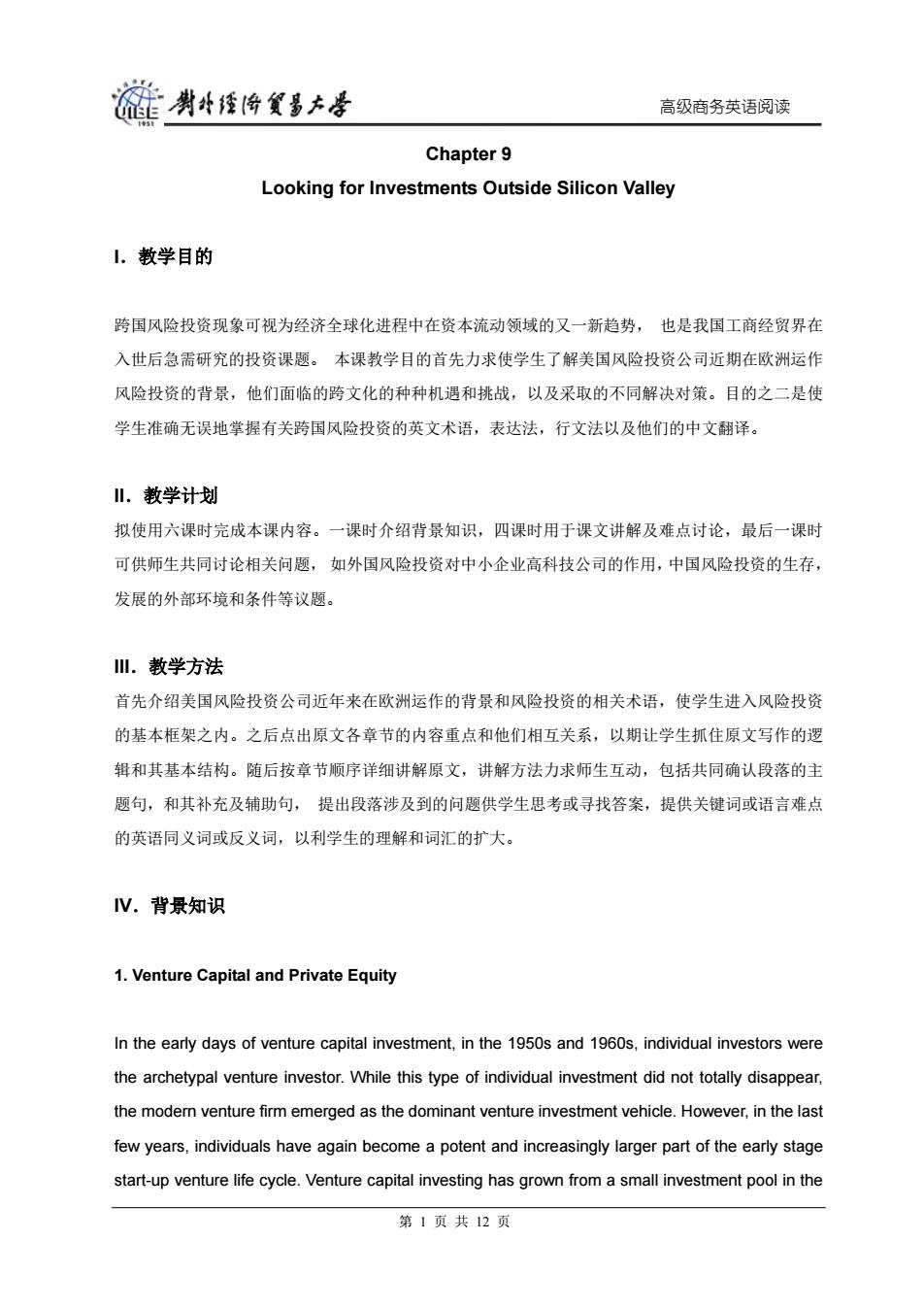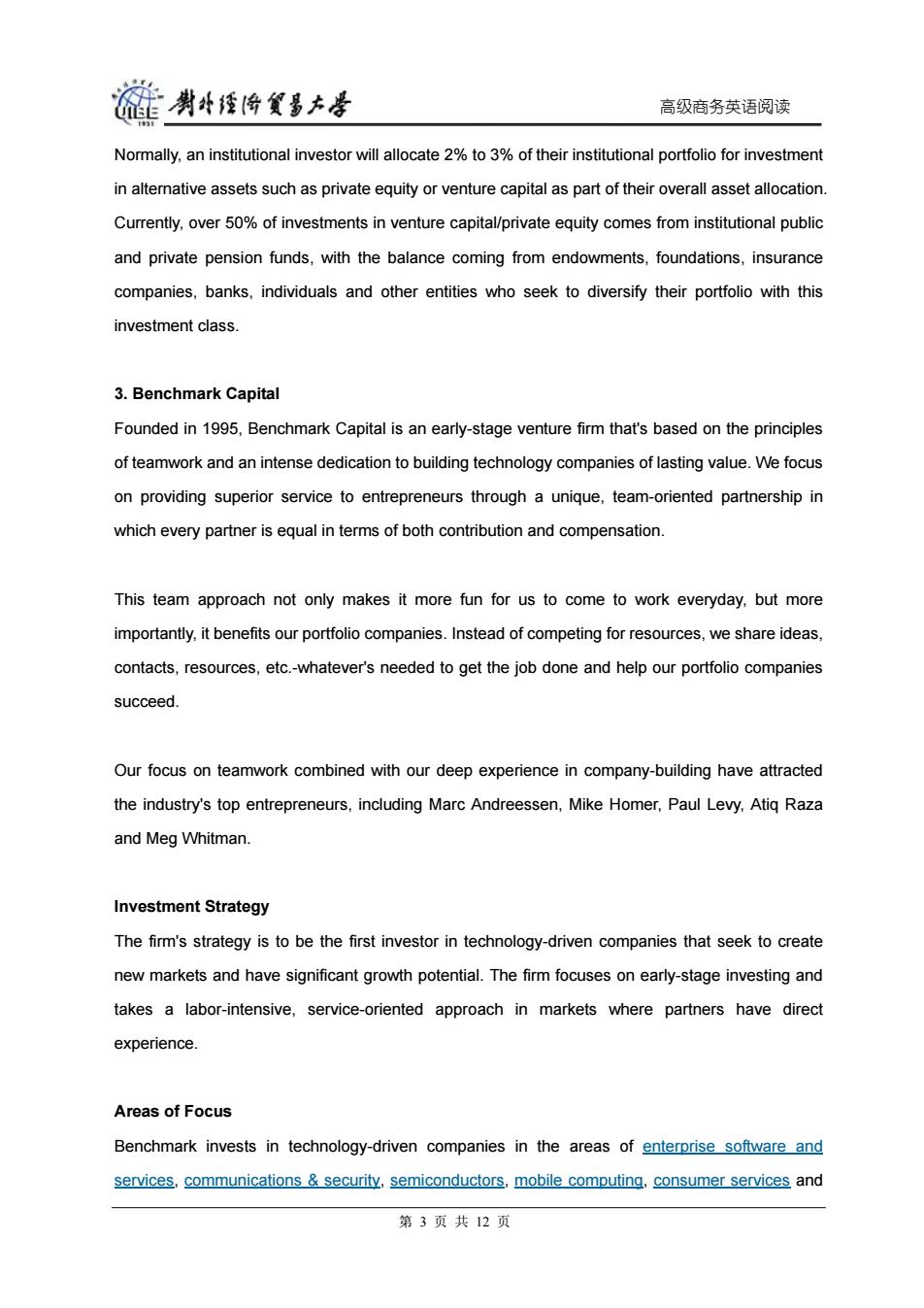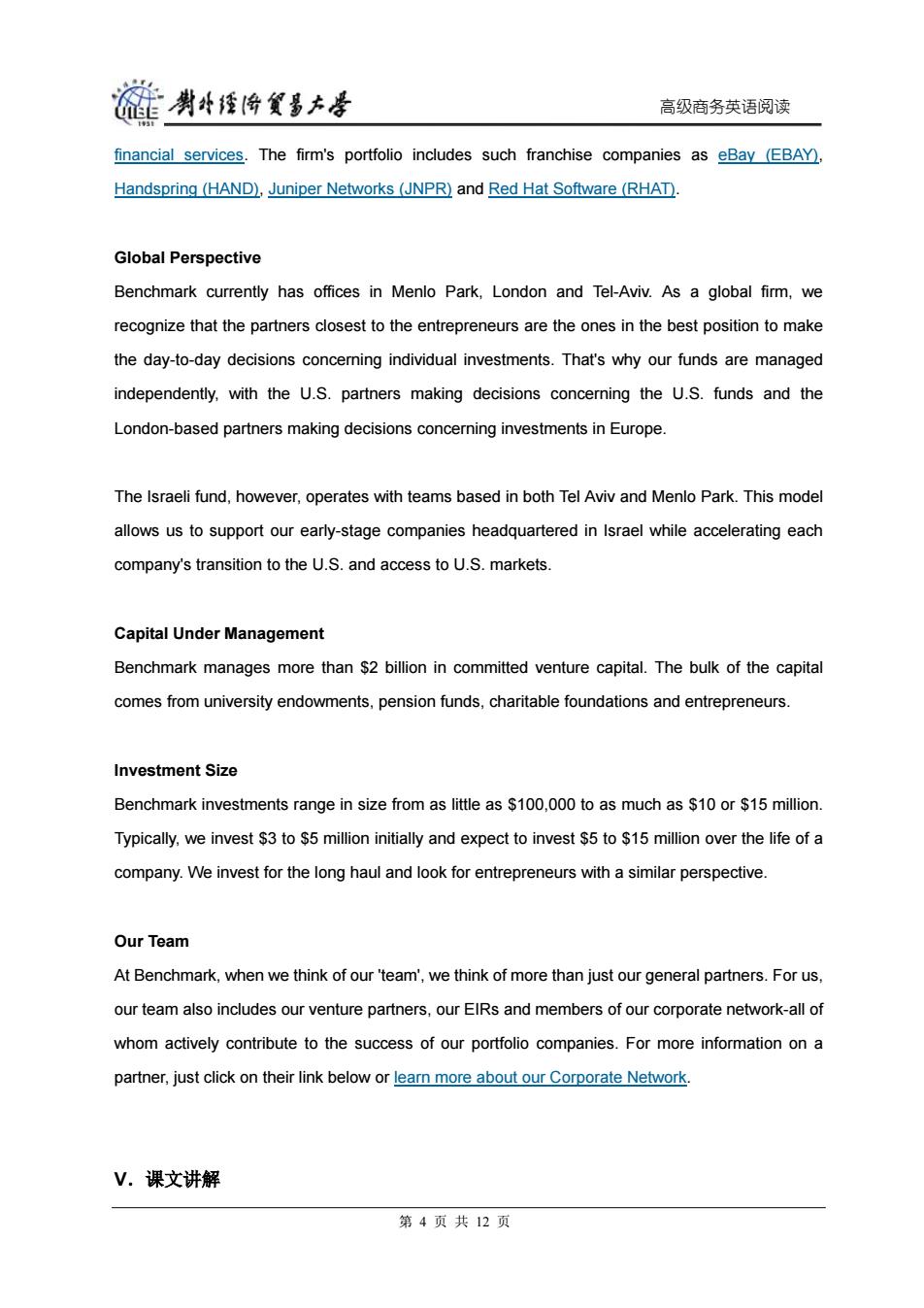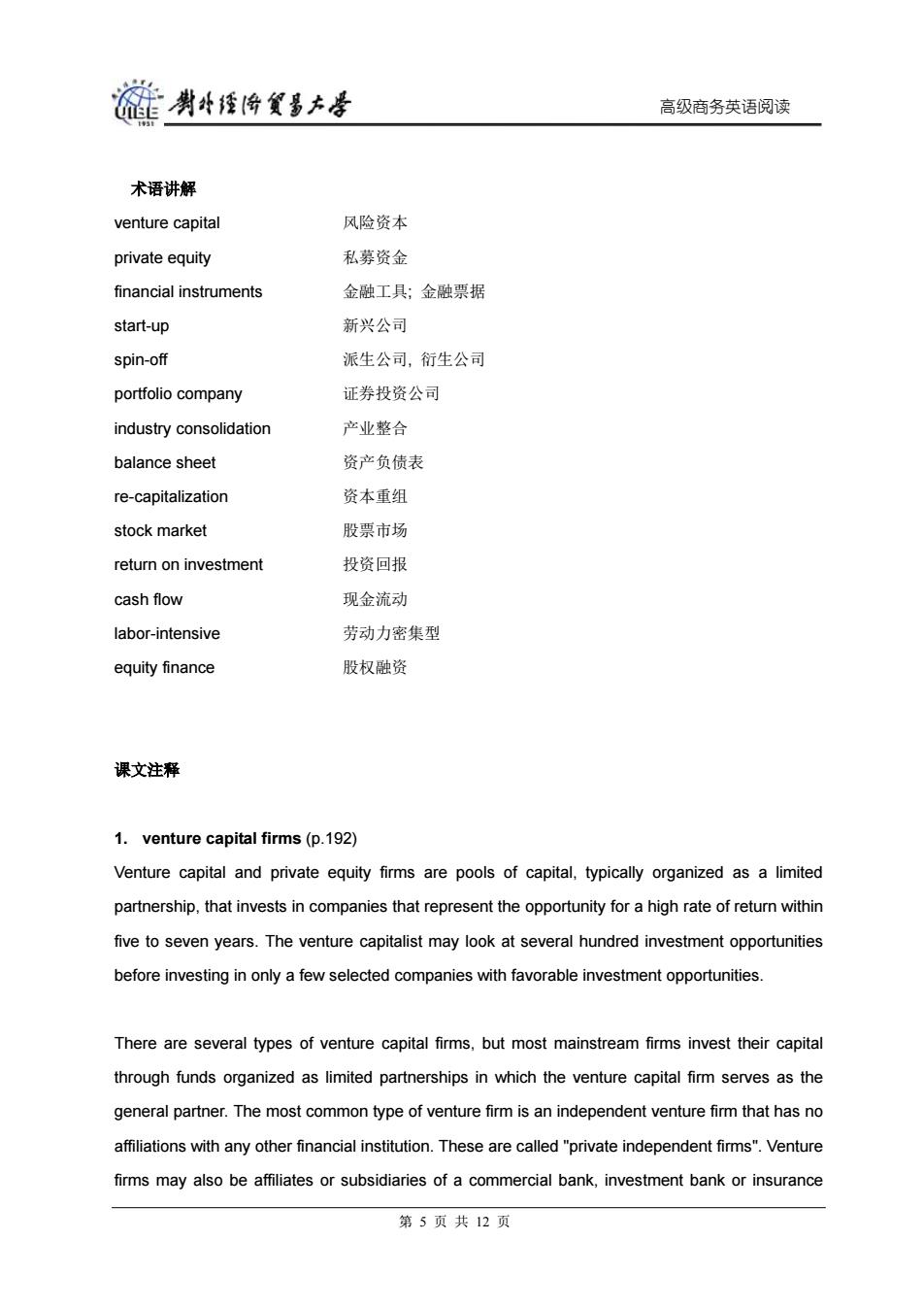
链典4矮降贸多大 高级商务英语阅读 Chapter 9 Looking for Investments Outside Silicon Valley 1.教学目的 跨国风险投资现象可视为经济全球化进程中在资本流动领域的又一新趋势,也是我国工商经贸界在 入世后急需研究的投资课题。本课教学目的首先力求使学生了解美国风险投资公司近期在欧洲运作 风险投资的背景,他们面临的跨文化的种种机遇和挑战,以及采取的不同解决对策。目的之二是使 学生准确无误地掌握有关跨国风险投资的英文术语,表达法,行文法以及他们的中文翻译。 Ⅱ.教学计划 拟使用六课时完成本课内容。一课时介绍背景知识,四课时用于课文讲解及难点讨论,最后一课时 可供师生共同讨论相关问题,如外国风险投资对中小企业高科技公司的作用,中国风险投资的生存, 发展的外部环境和条件等议题。 川.教学方法 首先介绍美国风险投资公司近年来在欧洲运作的背景和风险投资的相关术语,使学生进入风险投资 的基本框架之内。之后点出原文各章节的内容重点和他们相互关系,以期让学生抓住原文写作的逻 辑和其基本结构。随后按章节顺序详细讲解原文,讲解方法力求师生互动,包括共同确认段落的主 题句,和其补充及辅助句,提出段落涉及到的问题供学生思考或寻找答案,提供关键词或语言难点 的英语同义词或反义词,以利学生的理解和词汇的扩大。 IV.背景知识 1.Venture Capital and Private Equity In the early days of venture capital investment,in the 1950s and 1960s,individual investors were the archetypal venture investor.While this type of individual investment did not totally disappear, the modern venture firm emerged as the dominant venture investment vehicle.However,in the last few years,individuals have again become a potent and increasingly larger part of the early stage start-up venture life cycle.Venture capital investing has grown from a small investment pool in the 第1页共12页
高级商务英语阅读 Chapter 9 Looking for Investments Outside Silicon Valley I.教学目的 跨国风险投资现象可视为经济全球化进程中在资本流动领域的又一新趋势, 也是我国工商经贸界在 入世后急需研究的投资课题。 本课教学目的首先力求使学生了解美国风险投资公司近期在欧洲运作 风险投资的背景,他们面临的跨文化的种种机遇和挑战,以及采取的不同解决对策。目的之二是使 学生准确无误地掌握有关跨国风险投资的英文术语,表达法,行文法以及他们的中文翻译。 II.教学计划 拟使用六课时完成本课内容。一课时介绍背景知识,四课时用于课文讲解及难点讨论,最后一课时 可供师生共同讨论相关问题, 如外国风险投资对中小企业高科技公司的作用,中国风险投资的生存, 发展的外部环境和条件等议题。 III.教学方法 首先介绍美国风险投资公司近年来在欧洲运作的背景和风险投资的相关术语,使学生进入风险投资 的基本框架之内。之后点出原文各章节的内容重点和他们相互关系,以期让学生抓住原文写作的逻 辑和其基本结构。随后按章节顺序详细讲解原文,讲解方法力求师生互动,包括共同确认段落的主 题句,和其补充及辅助句, 提出段落涉及到的问题供学生思考或寻找答案,提供关键词或语言难点 的英语同义词或反义词,以利学生的理解和词汇的扩大。 IV.背景知识 1. Venture Capital and Private Equity In the early days of venture capital investment, in the 1950s and 1960s, individual investors were the archetypal venture investor. While this type of individual investment did not totally disappear, the modern venture firm emerged as the dominant venture investment vehicle. However, in the last few years, individuals have again become a potent and increasingly larger part of the early stage start-up venture life cycle. Venture capital investing has grown from a small investment pool in the 第 1 页 共 12 页

剥牛煙将多大是 高级商务英语阅读 1960s and early 1970s to a mainstream asset class that is a viable and significant part of the institutional and corporate investment portfolio. A tremendous boom began in the private equity industry in the early 1980s.The pool of U.S. private equity funds partnerships specializing in venture capital,leveraged buyouts,mezzanine investments,build-ups,and distressed debt grew from $5 billion in 1980 to over $125 billion in 1995.Private equity's growth outstripped that of almost every class of financial product.Despite its growth,the private equity pool remained relatively small.For every one dollar of private equity in the portfolio of U.S.institutional investors,there were about $40 of publicly traded equities in 1995. The private equity industry in the United States and international markets has been quite turbulent.If you had invested in average venture or buyout funds at a pace that tracked the U.S.market between 1980 and 1995,your returns today would be below those from investments in most public equity markets.For instance,venture-capital funds have been questioned,and even rejected by a great portion of American pension funds as they see venture-capital funds too risky,and not regulated by the US Securities and Exchange Commission. 2.Venture Capital(风险资本) Venture capital refers to the money invested in a company or business for development or expansion.It may provide a considerable income,but also carries a high risk of loss.However the definition of the term differs slightly in the various business contexts.In the British-American context,venture capital is often understood as early-stage investments,such as seed and start-up financing or expansion financing.In Germany,venture capital is more comprehensive,also including late stage capital,such as buyouts.While the former types of venture capital investments are crucial for the development and implementation of business ideas by young growth companies, the latter types are important for re-capitalization of more mature,small to medium-sized companies.Venture capitalists in the United States usually target high-technology sectors of the economy,while buyout firms focus on more mature firms in a variety of industries which need to restructure or combine 第2页共12页
高级商务英语阅读 1960s and early 1970s to a mainstream asset class that is a viable and significant part of the institutional and corporate investment portfolio. A tremendous boom began in the private equity industry in the early 1980s. The pool of U.S. private equity funds partnerships specializing in venture capital, leveraged buyouts, mezzanine investments, build-ups, and distressed debt grew from $5 billion in 1980 to over $125 billion in 1995. Private equity's growth outstripped that of almost every class of financial product. Despite its growth, the private equity pool remained relatively small. For every one dollar of private equity in the portfolio of U.S. institutional investors, there were about $40 of publicly traded equities in 1995. The private equity industry in the United States and international markets has been quite turbulent. If you had invested in average venture or buyout funds at a pace that tracked the U.S. market between 1980 and 1995, your returns today would be below those from investments in most public equity markets. For instance, venture-capital funds have been questioned, and even rejected by a great portion of American pension funds as they see venture-capital funds too risky, and not regulated by the US Securities and Exchange Commission. 2. Venture Capital (风险资本) Venture capital refers to the money invested in a company or business for development or expansion. It may provide a considerable income, but also carries a high risk of loss. However the definition of the term differs slightly in the various business contexts. In the British-American context, venture capital is often understood as early-stage investments, such as seed and start-up financing or expansion financing. In Germany, venture capital is more comprehensive, also including late stage capital, such as buyouts. While the former types of venture capital investments are crucial for the development and implementation of business ideas by young growth companies, the latter types are important for re-capitalization of more mature, small to medium-sized companies. Venture capitalists in the United States usually target high-technology sectors of the economy, while buyout firms focus on more mature firms in a variety of industries which need to restructure or combine. 第 2 页 共 12 页

喇牛煙将多大是 高级商务英语阅读 Normally,an institutional investor will allocate 2%to 3%of their institutional portfolio for investment in alternative assets such as private equity or venture capital as part of their overall asset allocation. Currently,over 50%of investments in venture capital/private equity comes from institutional public and private pension funds,with the balance coming from endowments,foundations,insurance companies,banks,individuals and other entities who seek to diversify their portfolio with this investment class. 3.Benchmark Capital Founded in 1995,Benchmark Capital is an early-stage venture firm that's based on the principles of teamwork and an intense dedication to building technology companies of lasting value.We focus on providing superior service to entrepreneurs through a unique,team-oriented partnership in which every partner is equal in terms of both contribution and compensation. This team approach not only makes it more fun for us to come to work everyday,but more importantly,it benefits our portfolio companies.Instead of competing for resources,we share ideas, contacts,resources,etc.-whatever's needed to get the job done and help our portfolio companies succeed. Our focus on teamwork combined with our deep experience in company-building have attracted the industry's top entrepreneurs,including Marc Andreessen,Mike Homer,Paul Levy,Atiq Raza and Meg Whitman. Investment Strategy The firm's strategy is to be the first investor in technology-driven companies that seek to create new markets and have significant growth potential.The firm focuses on early-stage investing and takes a labor-intensive,service-oriented approach in markets where partners have direct experience. Areas of Focus Benchmark invests in technology-driven companies in the areas of enterprise software and services,communications security,semiconductors,mobile computing,consumer services and 第3页共12页
高级商务英语阅读 Normally, an institutional investor will allocate 2% to 3% of their institutional portfolio for investment in alternative assets such as private equity or venture capital as part of their overall asset allocation. Currently, over 50% of investments in venture capital/private equity comes from institutional public and private pension funds, with the balance coming from endowments, foundations, insurance companies, banks, individuals and other entities who seek to diversify their portfolio with this investment class. 3. Benchmark Capital Founded in 1995, Benchmark Capital is an early-stage venture firm that's based on the principles of teamwork and an intense dedication to building technology companies of lasting value. We focus on providing superior service to entrepreneurs through a unique, team-oriented partnership in which every partner is equal in terms of both contribution and compensation. This team approach not only makes it more fun for us to come to work everyday, but more importantly, it benefits our portfolio companies. Instead of competing for resources, we share ideas, contacts, resources, etc.-whatever's needed to get the job done and help our portfolio companies succeed. Our focus on teamwork combined with our deep experience in company-building have attracted the industry's top entrepreneurs, including Marc Andreessen, Mike Homer, Paul Levy, Atiq Raza and Meg Whitman. Investment Strategy The firm's strategy is to be the first investor in technology-driven companies that seek to create new markets and have significant growth potential. The firm focuses on early-stage investing and takes a labor-intensive, service-oriented approach in markets where partners have direct experience. Areas of Focus Benchmark invests in technology-driven companies in the areas of enterprise software and services, communications & security, semiconductors, mobile computing, consumer services and 第 3 页 共 12 页

碰剥将多大是 高级商务英语阅读 financial services.The firm's portfolio includes such franchise companies as eBay (EBAY). Handspring (HAND),Juniper Networks(JNPR)and Red Hat Software(RHAT). Global Perspective Benchmark currently has offices in Menlo Park,London and Tel-Aviv.As a global firm,we recognize that the partners closest to the entrepreneurs are the ones in the best position to make the day-to-day decisions concerning individual investments.That's why our funds are managed independently,with the U.S.partners making decisions concerning the U.S.funds and the London-based partners making decisions concerning investments in Europe. The Israeli fund,however,operates with teams based in both Tel Aviv and Menlo Park.This model allows us to support our early-stage companies headquartered in Israel while accelerating each company's transition to the U.S.and access to U.S.markets. Capital Under Management Benchmark manages more than $2 billion in committed venture capital.The bulk of the capital comes from university endowments,pension funds,charitable foundations and entrepreneurs. Investment Size Benchmark investments range in size from as little as $100,000 to as much as $10 or $15 million. Typically,we invest $3 to $5 million initially and expect to invest $5 to $15 million over the life of a company.We invest for the long haul and look for entrepreneurs with a similar perspective. Our Team At Benchmark,when we think of our 'team',we think of more than just our general partners.For us, our team also includes our venture partners,our EIRs and members of our corporate network-all of whom actively contribute to the success of our portfolio companies.For more information on a partner,just click on their link below or learn more about our Corporate Network. V.课文讲解 第4页共12页
高级商务英语阅读 financial services. The firm's portfolio includes such franchise companies as eBay (EBAY), Handspring (HAND), Juniper Networks (JNPR) and Red Hat Software (RHAT). Global Perspective Benchmark currently has offices in Menlo Park, London and Tel-Aviv. As a global firm, we recognize that the partners closest to the entrepreneurs are the ones in the best position to make the day-to-day decisions concerning individual investments. That's why our funds are managed independently, with the U.S. partners making decisions concerning the U.S. funds and the London-based partners making decisions concerning investments in Europe. The Israeli fund, however, operates with teams based in both Tel Aviv and Menlo Park. This model allows us to support our early-stage companies headquartered in Israel while accelerating each company's transition to the U.S. and access to U.S. markets. Capital Under Management Benchmark manages more than $2 billion in committed venture capital. The bulk of the capital comes from university endowments, pension funds, charitable foundations and entrepreneurs. Investment Size Benchmark investments range in size from as little as $100,000 to as much as $10 or $15 million. Typically, we invest $3 to $5 million initially and expect to invest $5 to $15 million over the life of a company. We invest for the long haul and look for entrepreneurs with a similar perspective. Our Team At Benchmark, when we think of our 'team', we think of more than just our general partners. For us, our team also includes our venture partners, our EIRs and members of our corporate network-all of whom actively contribute to the success of our portfolio companies. For more information on a partner, just click on their link below or learn more about our Corporate Network. V.课文讲解 第 4 页 共 12 页

雒勇卧经降置昌大号 高级商务英语阅读 术语讲解 venture capital 风险资本 private equity 私募资金 financial instruments 金融工具;金融票据 start-up 新兴公司 spin-off 派生公司,衍生公司 portfolio company 证券投资公司 industry consolidation 产业整合 balance sheet 资产负债表 re-capitalization 资本重组 stock market 股票市场 return on investment 投资回报 cash flow 现金流动 labor-intensive 劳动力密集型 equity finance 股权融资 课文注释 1.venture capital firms(p.192) Venture capital and private equity firms are pools of capital,typically organized as a limited partnership,that invests in companies that represent the opportunity for a high rate of return within five to seven years.The venture capitalist may look at several hundred investment opportunities before investing in only a few selected companies with favorable investment opportunities. There are several types of venture capital firms,but most mainstream firms invest their capital through funds organized as limited partnerships in which the venture capital firm serves as the general partner.The most common type of venture firm is an independent venture firm that has no affiliations with any other financial institution.These are called "private independent firms".Venture firms may also be affiliates or subsidiaries of a commercial bank,investment bank or insurance 第5页共12页
高级商务英语阅读 术语讲解 venture capital 风险资本 private equity 私募资金 financial instruments 金融工具; 金融票据 start-up 新兴公司 spin-off 派生公司, 衍生公司 portfolio company 证券投资公司 industry consolidation 产业整合 balance sheet 资产负债表 re-capitalization 资本重组 stock market 股票市场 return on investment 投资回报 cash flow 现金流动 labor-intensive 劳动力密集型 equity finance 股权融资 课文注释 1. venture capital firms (p.192) Venture capital and private equity firms are pools of capital, typically organized as a limited partnership, that invests in companies that represent the opportunity for a high rate of return within five to seven years. The venture capitalist may look at several hundred investment opportunities before investing in only a few selected companies with favorable investment opportunities. There are several types of venture capital firms, but most mainstream firms invest their capital through funds organized as limited partnerships in which the venture capital firm serves as the general partner. The most common type of venture firm is an independent venture firm that has no affiliations with any other financial institution. These are called "private independent firms". Venture firms may also be affiliates or subsidiaries of a commercial bank, investment bank or insurance 第 5 页 共 12 页